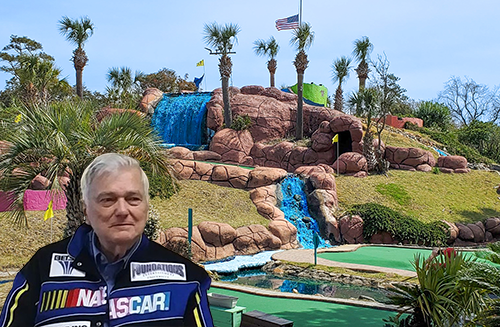 Miniature golf has been around for more than one hundred years and still has a broad appeal across all demographics. Why? The rules are simple; it can be recreational, therapeutic or competitive. In all forms it is relaxing, entertaining and one of the best participatory attractions that can be added to any family entertainment center, park district, stand-alone attraction and as once was very popular, an attraction to be added to residential back yards. Course designs come in all sizes and all budget ranges, themed and un-themed and various skill ranges.
Miniature golf has been around for more than one hundred years and still has a broad appeal across all demographics. Why? The rules are simple; it can be recreational, therapeutic or competitive. In all forms it is relaxing, entertaining and one of the best participatory attractions that can be added to any family entertainment center, park district, stand-alone attraction and as once was very popular, an attraction to be added to residential back yards. Course designs come in all sizes and all budget ranges, themed and un-themed and various skill ranges.
 This article addresses the thought process that we feel should be considered when developing a course design for a profit oriented facility in a smaller market. We've all seen the extremely themed courses created for competitive tourism markets, such as Orlando, Wisconsin Dells, Branson, Myrtle Beach and numerous other locations with millions of visitors each year. These also have fantastic construction costs to match, in some instances exceeding two million dollars or more. They look great and some even play great, but they are not even remotely viable for the general market. In addition very few provide ADA compliance over 18-holes, while some of the newer ones provide 9-holes of accessible fairways and people with disabilities are requested to repeat the nine for an 18-hole play. While it may meet the letter of the law, we do not feel it is in the best interest of your target market or the overall community to limit accessibility.
This article addresses the thought process that we feel should be considered when developing a course design for a profit oriented facility in a smaller market. We've all seen the extremely themed courses created for competitive tourism markets, such as Orlando, Wisconsin Dells, Branson, Myrtle Beach and numerous other locations with millions of visitors each year. These also have fantastic construction costs to match, in some instances exceeding two million dollars or more. They look great and some even play great, but they are not even remotely viable for the general market. In addition very few provide ADA compliance over 18-holes, while some of the newer ones provide 9-holes of accessible fairways and people with disabilities are requested to repeat the nine for an 18-hole play. While it may meet the letter of the law, we do not feel it is in the best interest of your target market or the overall community to limit accessibility.
The course you develop should have appeal for your local market, easily address ADA requirements, fall within a reasonable budget and stand the measure of time both in its physical structure and its ability to generate return visits.
Advent of New Pre-fabricated Courses:
Prefabricated miniature golf courses are not new, having been available for more than 50 years. In recent years several manufacturers have developed newer, plastic based panels and more creative configurations.
They offer ease of construction and apparently lower costs. Their products, however, require flat course surfaces and do not include drainage and grading design which must be performed by others.
Being restricted to flat design, they lack the impact of grading and other elements that can be accomplished with conventional design. A cursory review of their construction details indicates flat plastic panels connected at their corners, which could reduce stability and smooth course surfaces. in the event of uneven base settlement.
We feel they would have a valid value for creating indoor courses, but recommend conventional, multi-level, varying grade design for outdoor facilities.
Plan to Succeed:
Recognize the need to obtain all the information possible prior to making decisions that will have a major impact on your economic future. No one knows everything; this applies to potential partners, advisors and consultant. The collection of expertise, experience and judgment that can be assembled with a reasonable expenditure can greatly enhance the potential for success.
Should the projections developed in a feasibility study indicate a low potential for success, conventional wisdom would declare "run! Don’t walk" away from the project. It is far better to have invested in the small Study Fee than to lose your life savings or at least a significant portion of your net worth on a bad idea.
Such a decision does not mean there may not be another successful concept that could be developed, using the information developed in your initial study. This could be finding another site with a higher potential, looking at a different concept, attraction wise. Take the time to review your options before walking away from the industry.
It is important to initially consider not only your projected target market for initial guest visits, but also the ability of the course and guest experience to result in ongoing repeat visits in the future. The potential ability of any miniature golf course to generate returning guest visits is impacted by a number of elements other than course design. Among the most common decisions that are a result of failing to plan are the following:
Poor site location
ï Out of the way location
ï Bad neighborhood
ï Existing competition
Unattractive building and overall site
ï parking lot too small
ï parking lot surface poorly maintained
Poor overall guest site visit experience
ï Poor attraction design
ï Messy premises
ï Impolite or inattentive staff
ï Too congested
ï fairways too close together generating feeling of being crowded
ï Bad equipment
ï Lack of additional attractions to increase time of stay and better justification of travel time.
Avoid "Planning to Fail:"
Failing to Plan, is Planning to Fail. This can include failure to properly research and identify a concept that will fit your site, appeal to your target market and be successful; failure to recognize the need for properly utilizing skilled professionals to assist in identifying a proper concept, selecting a viable location, performing a feasibility study and obtaining sufficient financing to construct the project. It takes no special skill to fail and become part of the "road kill" that litters the road to ruin. A wise person knows what he doesn't know; while the unwise person has supreme confidence in his personal ability to make the right decisions.
Professionals to consider as important to your project team can include FEC consultants, real estate specialists, attorneys, planning and zoning specialists, bankers, etc. Each brings to the project knowledge and experience in creating successful projects. It is important to establish that each one you select has specific experience related to your specific project and site locale.
Location, Visibility and Access:
Many people plan to build their miniature golf courses on land they already own. This has a number of appealing aspects. You don't have to purchase an additional site and it is easier to operate from a travelling to and from work standpoint. This is great if you are located on a major highway and located in the target market you anticipate you will be serving. It's not so great if you are located several miles from a major highway on a local road, or at a point far from your target market.
The site should be well placed within your target market and located on an easily identified route for guest ease in locating the course. This is especially true for those people living beyond your immediate community. The public is fickle and doesn’t want complicated routes.
The facility must be visible from the road with a convenient driveway or access route. Visibility generates impulse and impulse guests can make up a significant percentage of your annual revenue.
Look Before You Leap:
Prior to leasing or purchasing your proposed site, you should also be aware of possible zoning constraints, floodplain or floodway restrictions and possible adverse soils conditions. For some locations there may be restrictions governing the location and design of driveways. You may have to share driveway access with one or more neighbors. Left turns may be restricted or prohibited.
While some or all of these issues may have already been addressed, or may not be issues at the site you are considering, it is important that you recognize that these issues can and do exist for some properties. Failing to make certain the property you are planning to acquire can be successfully developed may leave you with an expensive but unusable property. Make certain you have stipulations in your purchase or lease agreements that void the agreement in the event you cannot get approval from the governing agencies having jurisdiction, to construct your facility on the site.
Make certain you have sufficient funding and or borrowing capacity to properly develop your facility. This includes being prepared for weather delays, construction overruns and equipment and materials delays.
In the event you may have to apply for zoning variations, special use conditions, design reviews or other local hoops to jump through, build into your overall project development timetable a sufficient block of time to accomplish this.
Playability:
There are a number of varying opinions concerning the relative challenge in designing courses. Too difficult and you lose a portion of your guests and conversely, too easy and a different portion of your guests won't return. Unfortunately there is no exact formula for establishing the perfect mix.
Many operators want a number of simple fairway designs scattered on their course to provide the potential for more hole-in-one shots. Their philosophy being that it helps keep younger minds on the game better. This writer is of the opinion that a course can support one or two holes that are fairly obvious par 1, but that it will be more likely that your course will generate greater frequency of guest returns by concentrating on fairways with par values of 2 or greater. Creating fairways with more entertainment value is primary. Increasing fairway par value does not mean making the play so difficult that it frustrates players (leave that for full size courses), but rather providing additional entertainment value. Including a few unique trick shots involving flowing water, multi-level or multiple approaches to the cup can be accomplished in such a way that even unskilled players can complete the course with reasonable scores. This also helps increase the attention span of younger players.
Handicap Accessibility is an important element in developing modern miniature golf courses. We have always designed our miniature golf courses to be accessible on all 18-holes for obvious and practical reasons. Physically challenged people include far more than people needing mechanical assistance, being it wheelchairs, crutches, walkers and other items, but also mothers with strollers, adults with arthritis and similar challenges. None of these people should be denied the same entertainment experiences as your other guests when it is so easy to design accessibility into the entire course. The play can be just as challenging and entertaining while adhering to ADA regulations and the result will be positive in terms of guest visits ultimately generated.
In considering the overall scope of your course design, keep in mind the reality that large courses with extensive landscaping, supplemental structures and extensive artificial stone elements are not necessarily any better at generating repeat business (unless you are located in a major tourism area where your competition is extravagant and curb appeal carries the day). This article is not intended to address this special market.
Bigger isn't Better:
On many fairways we've seen, wide expanses of surface are never used for ball movements. This increases the Contractor's revenue, but doesn't mean the course will generate any additional revenues for you. Playability is determined far more by the configuration and grading of the fairway, not the expanse. While playability will not be affected by reducing the surface area of the fairway design, it can certainly reduce overall costs. Keep in mind the larger the fairways and the larger the overall course area, the higher the initial cost and the resulting ongoing maintenance and replacement costs (carpeting every five to seven years).
The proper planning of the course in terms of using effective playing surface economy and maximizing the use of the space set aside for the course can result in having extra space and funds for the addition of other attractions; which can increase average stays, attracting more for guests at the periphery of your target market and a resulting increase in your bottom line.
Landscaping, themed elements and related elements:
There is no doubt having a pleasing course environment can contribute to generating repeat business. The reality is it does not have as much impact on repeat business as a well-planned playing experience. When considered in that context, it can still be a part of the overall experience and when done well, is a positive element.
Well planned landscaping can enhance the playing experience of many guests, but it will not drive the business. This is not meant to discourage sound landscaping, but rather to express the opinion that landscaping is secondary to the playing experience the course provides.
Keep in mind that every element has initial costs as well as ongoing maintenance costs that can, if not taken into consideration at the beginning result in substantial increases in overall cost. Beyond the impact on the initial construction budget, there is the ongoing cost of maintaining, repairing, and painting and in some cases replacing elements that do not in themselves generate added income.
This writer would never plant turf grass within the confines of the course. It can be labor intensive, moving mowers in and out plus follow-up cleaning. These areas are difficult to mow and maintain, resulting in the need for cleaning up clippings on the fairways and walkways. Mowing debris can mess up streams and ponds, including potential pump repairs.
Deciduous trees and shrubs are also poor elements to add to a miniature golf course because of the potential of leaves dropping on fairways. If the client wants to use deciduous plantings and/or trees, serious consideration should be given to those that hold their leaves the longest to minimize fairway cleanup. Evergreens are acceptable. Keep maintenance of landscaping in mind when planning your course. Deciduous trees, shrubs and other plants drop leaves and leaves need to be kept off the fairways and grass needs mowing. It's not easy moving lawnmowers around a mini-golf course and clippings need to be blown off the fairways as well. If allowed to accumulate leaves and grass clippings can plug the small diameter piping used for draining the course area. Grass, annuals and perennials require watering. All of the above labor intensive items can be greatly reduced by using pea gravel, crushed stone, river rock or similar materials in all of the unpaved areas of the course.
When your site has mature trees, planning your fairways and sidewalks in a manner that minimizes encroachment within drip line will reduce potential damage to the trees. We strongly recommend employing the services of an arborist to assist in proper pruning of branches and exposed roots to maximize guest safety and tree survival.
Be aware of the potential problems that can arise with using organic mulch. It can blow around, wash over sidewalks and fairways in heavy rains and if it has been colorized, stain sidewalks and possibly fairways.
Water Features:
Water features are a common amenity added to most miniature golf courses for both audio and visual effects and in this writer's opinion are positive elements. The size and complexity of the features are more of an individual decision. There are a number of options that can be followed in the event the budget hits a stone wall.
For plans that call for waterfalls and, streams and ponds, initially grade stream beds, receiving pond and pump piping system but hold off installing the pumps and construction of the waterfall until second or third year. In this format you will be able to fill the receiving pond and use aerator pumps to create a fountain like effect at a minimal cost.
Construct stream, receiving pond and pump system. Construct a small waterfall simulating a spring and hold off final feature waterfall construction until second or third year.
Develop a waterfall design that can be expanded over a period of years as funding becomes available. Construct stream, receiving pond and pump piping system.
Generating Return Visits:
It is important to initially consider not only your projected target market for initial guest visits, but also the ability of the course and guest experience to result in ongoing repeat visits in the future. The potential ability of any miniature golf course to generate returning guest visits is impacted by a number of elements other than course design. These include the comfort and appeal of the overall facility, the cleanliness and appearance of the physical plant and the treatment as guests rather than customers. A friendly smiling staff trumps a curt or sullen one every time. Make your guests feel they are important and that you truly hope they have a good time. Part of this is empowering your staff to feel they are part of the experience, not just employees.
Simple elements, such as play areas for toddlers, shade structures, benches on the course between fairways and related creature comforts can all contribute to guest satisfaction
Move and Improve:
Once you've opened your facility, you have to stay aware of your competition, changes in the industry, motivation of your staff, evaluate your marketing and ways to improve the "status quo." Failure to continually consider your current operation against your future goals can easily lead to stagnation not only of your physical plant and the image presented to your guests, but also in the progress you originally planned on achieving.
Think Outside the Box:
Don't be afraid to think outside the box in terms of your operations. Produce special events, tournaments, contests, seasonal theming for days or seasons such as New Year's Day, Easter, Memorial Day, Fourth of July, Labor Day, Halloween, Veterans Day, Thanksgiving and Christmas. Not all the above are practical in the Frost Belt, but consider using the ones that are celebrated during your operating season. There are many other days, or seasons that could be used to add something different and interesting.
There are many local organizations, such as schools, churches, fraternal and business organizations that may be interested in fund raisers, recognition days and related events. Create your own concepts. Be realistic, but don't be afraid to move out of your comfort zone. Every facility needs occasional changes to avoid becoming yesterday's news. Stir things up once in a while.
Peter is a Licensed Professional Engineer in the States of Illinois and Michigan and is President of Entertainment Concepts, Inc. (formerly Peter F. Olesen and Associates, Inc.). He founded the firm in 1984 and expanded its range of consulting services over the years to now provide a wide range of consulting services. Services range from preliminary site evaluations, feasibility studies, business plan assistance, concept development, master planning, design and construction engineering services that apply to new facilities as well as renovation or expansion of existing facilities. Projects include the design of both outdoor and indoor, family entertainment centers, amusement parks, theme parks, stand-alone go-kart tracks and miniature golf courses, bumper boat ponds and related attractions. The firm has been and continues to be at the forefront of go-kart, miniature golf course and bumper boat pond design, introducing many innovations in safety, geometrics, design and construction methods now widely emulated throughout the industry.
To date the firm has completed more than 670 projects spanning 46 states, Angola, Brunei, Canada (Alberta, British Columbia, Ontario, Quebec and Saskatchewan), Cuba (Guantanamo Bay), Kazakhstan, Mexico, Puerto Rico, Saudi Arabia and Vietnam. Since 1987 Mr. Olesen has exhibited at more than 100 industry trade shows. He is a member of the faculty of Foundations Entertainment University (49 seminar presentations over 17 years), participated in more than 100 seminar presentations at the International Association of Amusement Parks and Attractions, FunExpo, Kart Expo and Leisure Expo, as well presenting go-kart safety seminars for the State of Ohio. He has, and continues to author articles for industry magazines and internet newsletters. For additional information on projects and services offered please refer to our web page www.fecdesigners.com or contact us at 847-561-7013 or www.peteolesen @yahoo.com.
Copyright: Entertainment Concepts, Inc. 2024






